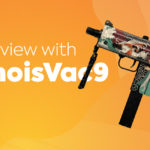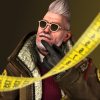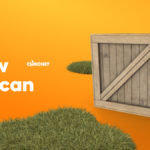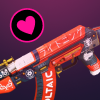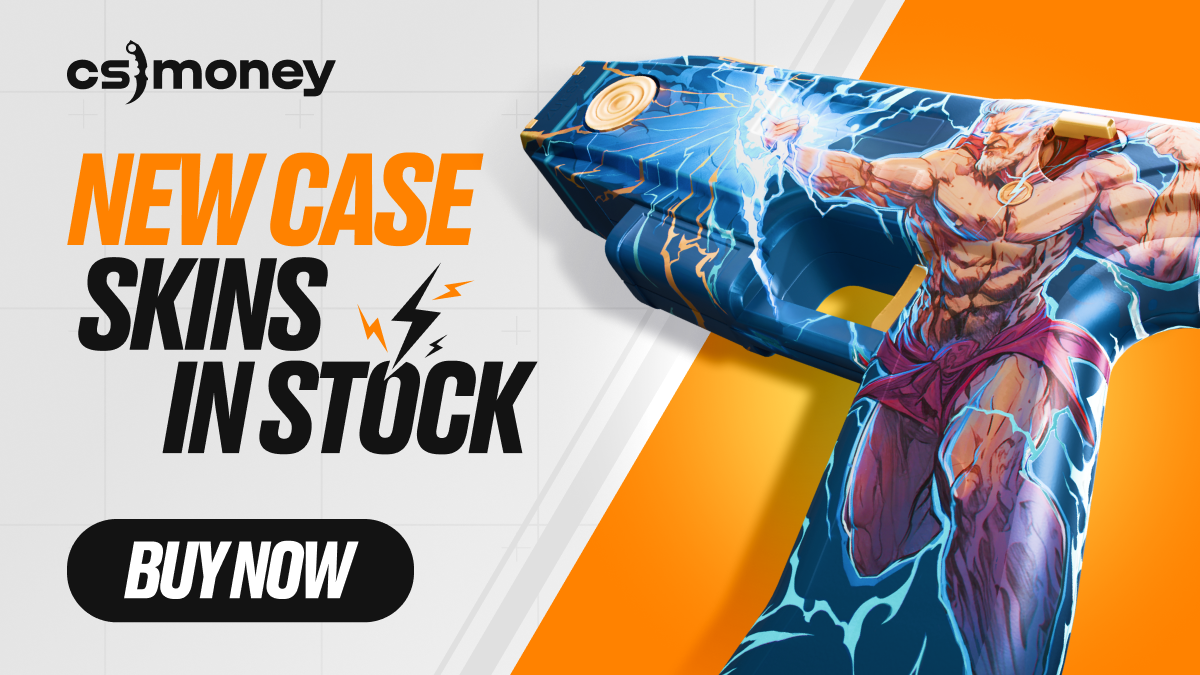It’s amazing how many interesting and distinct people can work on CS:GO skins and how different their approaches can be. Confident and seasoned crafters who take it as business and do it for money; sophisticated masters of art, investing their souls; simple folks who were able to turn their personal hobby into a dream-come-true; lucky beginners and unlucky old guards; and many others.
CS.MONEY Blog opens a series of interviews with Recoil Case skin authors. Today, we introduce you to Steve “Cimota” and Chris Parra, two skinmakers from Australia, and their beautiful P250 Visions.
Here, we talk about P250 Visions, our leading role, Chris’ creative nature (spoiler: he is an artist and tattooer) and Steve’s mentorship (even though he denies it), the skinmaking community, balancing, finances, full-time worth, and a lot of other stuff.
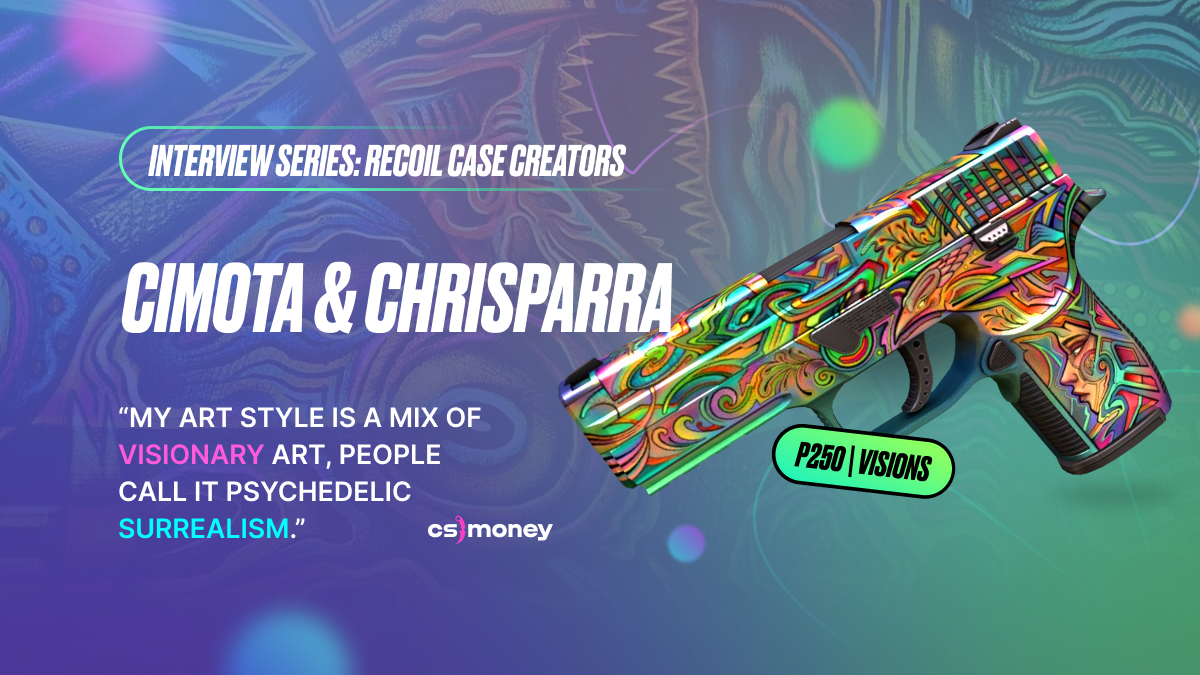
Until 2020, Cimota was an electrical-mechanical engineer for roughly 12 or 13 years. Then, COVID hit and it changed everything. That’s when he started going into skins. Ever since, he hasn’t been looking back. “I’m a bit enthralled with skinmaking and the community at the moment,” he says.
Chris, born in South America, Colombia, has been living in Australia for the last seven and a half years. He started making skins because Steve texted him one day over at ArtStation and asked if he would like to make skins for CS:GO. “At first, I didn’t even understand what he was talking about. <laugh> Then I checked his portfolio and I was like, holy shit, this guy is sick.” And he accepted.
Today, Chris tries to combine being an artist (painter, illustrator, tattooer) and skinmaker. Under Steve’s wing.
Skinmaking: Responsibilities & Inspiration
Even now, a while after being announced for the Recoil Case, Chris is thrilled and utterly happy.
“I don’t have any words to say. It’s incredible. P250 Visions was the second skin I have ever designed. The first one was AK 47 Sibylline Abstract which I think was an introduction for me to skinmaking, but basically, Cimota told me everything about the technical aspect, how to make a gray scheme, etc. And then after that one, basically he just trusted me and he let me fly by my imagination and my creative criteria. That’s pretty awesome, to be honest, <laugh>, I’m very happy.”
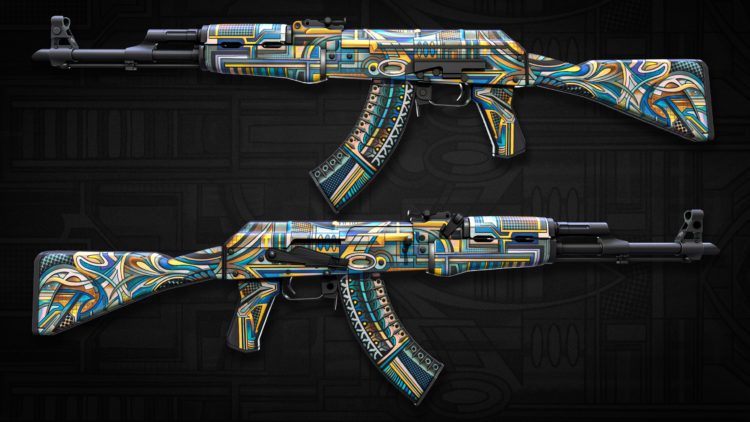
With Chris being a newcomer to skinmaking, how do you guys combine and set up work?
Cimota: It’s pretty cut and dry. Chris is the one who does the art side of things. But as he said, he’s never really done any skin design before. So, for example, the P250 Visions, as he just explained, was the second skin he’s ever made. He’s never even really played CS:GO as an example. As an example, let’s look at what is done from my end compared to his end.
I had to pretty much teach him how the entire process works. Chris has never done CS:GO, he’s never played CS:GO, and he’s never made skins for CS:GO, but the art side of things it’s second to none, his artwork is amazing. So we design a little template, like say, for P250, it’s basically a flat image of the side of P250. He’ll design the artwork for it, and then he’ll send it over to me, and then I’ll apply it to the gun, and do all the materials and texturing that needs to be done on top of it. Then, add normals, which is the 3D work side. And for his specific artwork, just because it’s so complex, there are a lot of issues that come along with it just because there are a lot of cleanups, which probably takes as long as the artwork takes to be fair.
So Chris does the artwork. I do everything else until he’s more competent or until he learns how to do the other side of things. I’ll do materials, the promotional work, the 3D renders, the screenshots in-game, getting the test in-game as well. But for the time being, Chris is just purely working on the artwork and then it just back and forth between each other.
But like I said, he hasn’t really done anything with skins or CS:GO before. I wouldn’t say I am directing him, it’s me and him going back and forth on where the artwork needs to be placed. My biggest pet peeve is seeing artwork just slap on the side of a gun and then just calling it a day. It needs to look like it’s fitting the gun. It needs to look like it’s designed for the actual gun and flow with the shape of the weapon properly.
What was the inspiration? Why did you choose this particular art style, patterns, concept, etc?
Chris: When I make a design for a weapon, Steve sends me the templates. Then, I do an examination of the anatomy of the weapon. Then I will start sketching some gestures or guidelines to discover where are the areas to cover and where are the areas that we prefer to not touch because of the distortion and much other technical stuff. After that, I will go back to my sketchbooks and I start looking for ideas or good shapes that will fit into the guidelines or the shapes of the weapon. And I will try to apply them in harmony with the model, with the weapon.
My art style, it’s always been the same. It’s a mix of visionary art, or as other people call it, psychedelic surrealism. And it’s based on my personal experience with psychedelic or sacred plants. So the idea or the concept about the weapon is just Cimota letting me be myself and keeping in mind to create something that is not seen before in other weapons.
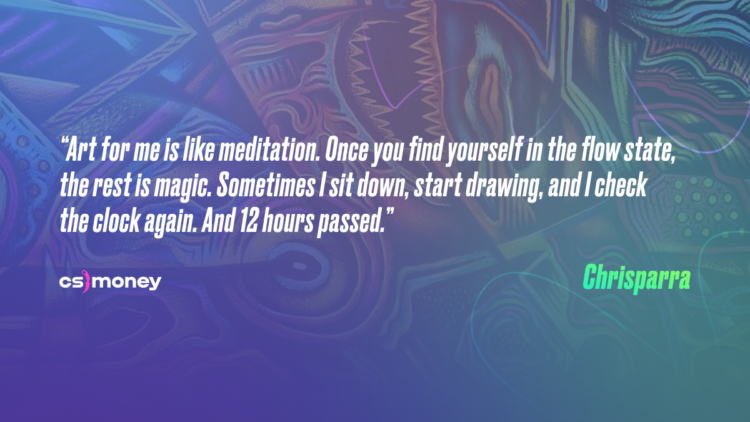
Were you suggesting that you would get into the Recoil Case, or was it a surprise?
Cimota: I told Chris from the very beginning: do not get your hopes up, do not think that you’re gonna get into the case, you most likely will be disappointed. Every three to six months a case comes out, there’s only 17 skins selected on average. There’s roughly 200,000 skins in the workshop. Don’t get your hopes up. As long as our quality is in the top 1% of the workshop, we have a better chance than the other 99%, but still that 1% could be 10,000 skins on average, for example. There’s a chance that we might get in. And there’s a very, very good chance that we won’t get in.
But yeah, you’re just gonna have that mindset. Many people go into skinmaking just to make money or whatever it is, and don’t get me wrong, I do it to make money as well. It’s my living. But you can’t start creating skins to the point where you think you’re gonna be accepted after one skin, after 200 skins, because Valve doesn’t owe you anything. They don’t say, “Oh, this guy’s made 200 skins. That means he is worked 300 hours. He deserves to make some money and get a skin in the game.” Doesn’t work that way. You need to be very, very lucky. Honestly, it’s basically like a lottery. If you have 200,000 submissions on the Workshop, 17 get selected. I’m very bad at math, but you can figure out the odds.
On P250 Visions & Balancing
Working on P250 Visions was exhausting, wasn’t it?
Chris: For me, P250 Visions was the most time-consuming weapon I’ve ever done. I spent probably 70 to 80 hours just drawing. Plus, when I sent it to Cimota, some things didn’t match, like having distortion in the borders, and he had to fix some stuff or tell me to change this and that. So basically it was way more hours in the end. It was very difficult, but at the same time at the end, it was pretty worth it. Like doing an acrylic or oil canvas, you know? It’s pretty time-consuming art, even though it’s digital, where you can change stuff easier, like saturations, shapes, all that.
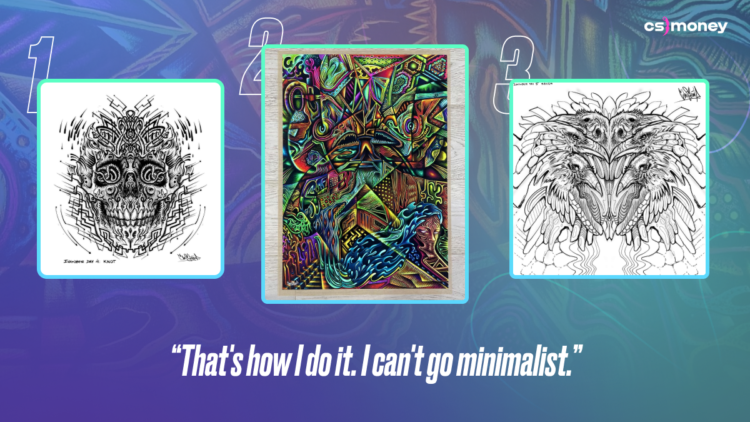
But also I was looking to do something very clean, make a very good design that was clean, was visible in CS:GO, where you have many skins that are pretty simple. You have other ones that are very complicated, but when they’re very complicated, full of details, sometimes you don’t even understand what’s going on. So I was trying to do something that was readable and understandable for the viewer. It is not easy when you need to put a lot of quantity of details, emotions and feelings into the weapon. Because as I say, when I do art, I just put a little bit of myself in every kind of what I do.
Cimota: It was Chris’ second skin and he was still learning my process and pretty much what the standard would be for making skins. So for example, we did, I don’t even remember how many different iterations. Say, for example, the face on the handle, that was pretty much always the one to be there, the main component. But we changed that bird three times. There was another face, a different snake, two birds at one stage, I think even another head at the back or near the handle trigger. Yeah, the snake wasn’t there at the first place, there were different flowers at one point.
Chris: [With this skin,] you need time to discover what’s going on. If you see my art, you start checking details. And there is a lot of things going on.
Cimota: I remember doing the P250, at the beginning. I said, “Chris, let’s do something simple.” He’s like, “I can’t f**king do simple Steve.” <Laugh>
Chris: It’s true! I’m sorry, bro, I just can’t, it’s just my way. That’s how I do it. If you go to my workshop, or my ArtStation or my Instagram to see tattoos, it’s always the same thing. I can’t go minimalist. And that’s why I love the AK 47 Vulcan: for me, even though it’s not the simplest thing, it’s just so well-balanced. I do the same. I balance everything: colors, gradients, saturations, shapes. But I can’t go that simple. So I admired these kinds of things that is kind of opposite to mine, but at the same time, they work very well.
Can you tell me about the face on the grip?
Chris: My whole art is visionary art or psychedelic surrealism based on psychedelics and sacred plants. When I create art, it is based on my personal experiences. So I always create something related to what’s happened to me. So it’s kind of putting myself a little bit in the art, but at the same time, I have to create something that sells, and that people would like and it’s gonna be attractive. So it’s a little bit of both at the same time.
By the way, right now, I have a customer who got that girl as a tattoo on his calf and the bird in the knee. And now I’m doing the full sleeve for the theme.
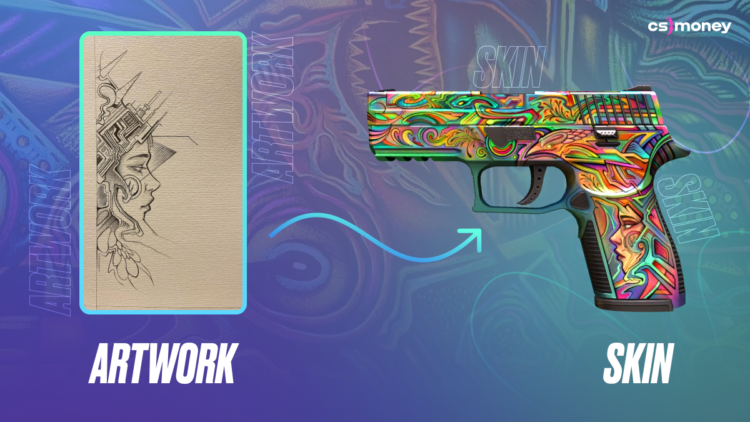
Does he know?
Chris: Yeah! I told him. And he’s happy, of course, because he plays the game as well. He knows everything. So he’s pretty happy about having part of the P250 Visions in his skin forever.
This face is basically the main character and all things happening around is coming from this person’s head. This is how I imagine it, how I interpret it as well.
Chris: Well, art is very subjective as well, you know? Sometimes with art, you don’t need to explain, maybe the viewer is gonna interpret themselves subjectively. So I always just let it go as it comes, it’s like magic, art for me is like part of a meditation state. And I find myself in a flow state, the rest is basically magic. Sometimes I sit down, I start drawing skins and when I check the clock again… Twelve hours passed, eight hours passed. <laugh>
You also mentioned that you have to work with balance between self-expression and guessing what the audience wants. Is it hard?
Chris: It’s the same when I do tattoos because tattoos are for people, but people understand that it’s my self-expression. That’s why they pick me. And I think that’s why Cimota picked me as well. I’m very honest with myself when I create art, I just do my style, I just do my thing. And in my opinion, it will go 50/50, because, at the same time, I feel I have to be honest and to create something unique, this is a very difficult thing to do. But to make it less difficult, I just try to keep my style and identity solid.
But you have to please the audience, and you have to please the community, you know?
Cimota told me: “Look, dude, these are the skins I selected. You should check it out.” But when I was checking out, I was like, “yeah, okay, I don’t wanna redo something that is done already.” I think just by being myself it was the only way that we could get accepted. The balance was worth it this time.
Cimota: Yeah, you need to find that sweet spot. You need to be happy with the work that you’re producing. And what’s probably more important besides yourself, you need to make sure the audience and the developers like the work too.
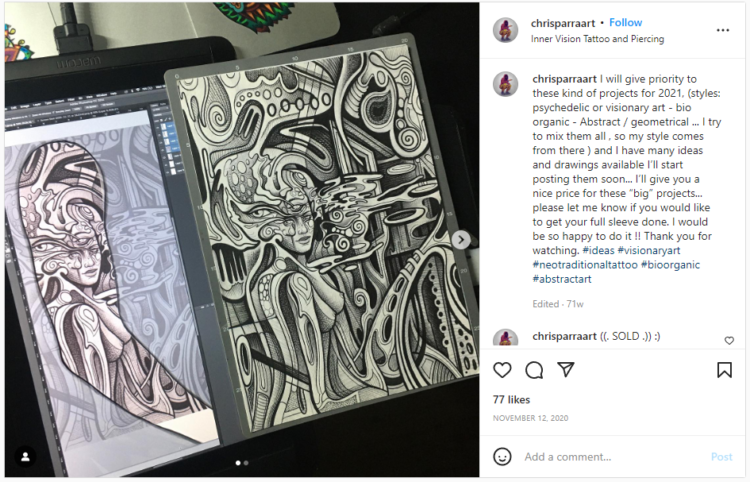
Financial Part & Skinmaking Full-Time
Once an engineer, Cimota could make a living from an ordinary job. But not anymore.
Does it bring enough money?
Cimota: It’s very difficult to answer… Prior to skin making I had a successful career then COVID hit and then I went full time skin creating. Everyone’s situation is different but I’ll give my perspective and advice if someone is looking to do this full time.
For someone looking to do this full time, you need to remember you aren’t being paid for your time, it’s not a job. If you have other ways to support your family, friends, mortgage or rent or what ever your situation is, then you can devote time and energy into making skins.
I’ve had friends, for example, who have been making skins for years without any accepts, I couldnt imagine doing this solely full time without any accepts or other forms of income to to live.
I don’t want to discourage people to create skins, or get into this space whatsoever. If its something you’re passionate about, go for it. There is nothing wrong with doing it as a hobby in hopes it becomes something more at a later time.
Chris: My case, I’m a tattoo artist, a painter, and Steve told me, “Dude, don’t get confident.” And when you check the workshop, there are many, many amazing artists doing incredible work out there. Don’t take it as “Okay, I’m gonna make skins. I’m gonna win.” It’s difficult, man.

Other Skinmakers, Mentorship, And The Community
You guys seem pretty much like a mentor and a student.
Chris: Yeah. We’re a good match. Steve’s like my teacher, but at the same time, he just let me be myself and says, “Dude, let’s go for that one”. And I just check my sketchbooks and start going for it. And we never plan something from zero. It’s like artwork, I treat it like a canvas. I am an Artist. So I create the weapons as same as when I do my paintings or when I do my tattoos. I check what the canvas is, and what is the shape. And after that I will just go for it and it, it kind of comes by itself, you know?
Cimota: It’s pretty funny. I’ve been following his artwork and his art style for a little while. And I’m thinking to myself, we’ve got colorful skins in CS:GO, but we don’t really see much of Chris’s art style there. I’m thinking to myself, f**k it. Let me see if I get a hold of this guy. And then I just message him like, “Hey mate, you wanna make some skins?” And he’s like, yeah, let’s do it.
Chris: But it was basically COVID, because other ways I will say, sorry, I have a lot of too much shit to do. But with COVID, he timed perfectly. And when I checked his portfolio, I was impressed.
Cimota, you have many skins you made with someone else. And Chris is not your first apprentice. How does this work for you?
Cimota: I wouldn’t say I’m a mentor. I think the only person that I’ve actually collaborated with who has no idea about skin-making in CS:GO would be Chris. Everyone else have made skins before. And I wouldn’t collaborate with someone brand new, unless it’s someone that I really want to collaborate with.
And there’s another young guy I’m working with now, with whom I’ve made an MP9 Superlight. He has a lot of potential, but he needed a bit more guidance in terms of where it’s going, where he can push his skins in the right direction because his skins were great to start with, but they can be so much better. So, just to push him over to a line and give him that edge where he probably wasn’t before, because I’ve got a very high attention to detail.
One of the main reasons I started making skins for CS:GO was because of MultiHawk. Without his help in the very beginning i would be utterly lost and useless. He explained the process entirely and was extremely helpful getting me started on my journey. And I learned so much in a short amount of time to the point where my first skin that got into the game was a collaboration with MultiHawk. “All right, cool, I can do lot, I know I can work with people of his caliber, let me see what I can do with some other people at the same time.”
So I reached out to Chris and some other people, but honestly, mentorship is amazing. If the person on the other side actually wants to learn and absorb the information. I wouldn’t say I’m a mentor by any means of imagination, but at the same time, it’s Chris’ second skin ever made. And we were noticed to the point where we actually got into CS:GO. So that’s amazing. I’ve got no other way of describing it, so I’m not trying to sound egotistic or something along those lines. I think we’ve both done something right to get this far.
Can you tell me about the community?
Cimota: I’m very friendly with a lot of skinmakers. Half my friends list on my Steam is basically them and I speak to some of them daily, probably more than some of my friends in real life. I’m also a part of a CS:GO Workshop Discord with a bunch of amazing creators, and we all friendly with each other. That group of people, they’re amazing. For example, if they’re working on a skin, they’ll post their ideas or their progress pics, and we can give them feedback and bounce ideas off each other.
And they’re very, very helpful. But I think it’s very hard if you’re getting into skinmaking per se and you don’t have that type of connection with a few people just because you’d have to rely on yourself or your normal friends who might not know about skin making to try bounce ideas off. So I think there’s a bit advantage in terms of being part of that kind of community, where you have someone like, for example, EgoDeath. He made Galil ChatterBox, he’s very, very active in his Discord. He’ll show progress pics, post ideas, they bounce off each other, and he gives good feedback and stuff. So in all honesty it’s really, really good.
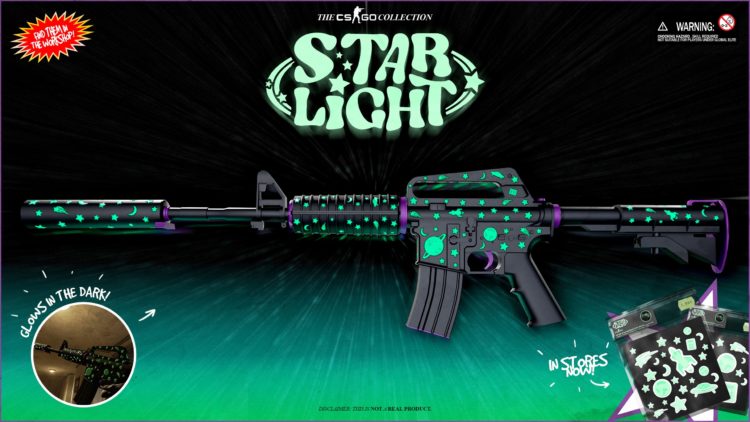
Promoting Skins Can Be Essential
Another piece of advice Cimota wanted to add was about the work around a skin, placing it correctly on the Workshop and reaching out to people’s hearts.
Cimota: Skinmaking and having nice design skins is one thing, but make some nice promotional work as well. A nice rendered image for your thumbnail and a few first proma pages. And some gifs.
It’s not just about the skin. I treat it like a business personally. If you look at the start of my workshop compared to today’s skins, it’s night and day. The skins were somewhat nice back then, but the quality of presentation… Use Twitter or other social media platforms to promote works and renders and everything else in between, I think that’s very, very important. But in saying that you can slap the image of the gun, just a screenshot of the weapon as thumbnails—that’s been accepted before. So don’t take my word as gospel, but I definitely do feel it does help a lot.
Cases, Skins, Ranks, Stickers and Other
What thematic case would you like to see in CS:GO?
Cimota: It’d be something apocalyptic. All the skins are worn and torn and it is just all f**ked up. I like very grungy type skins, even though I make very colorful skins. If I had to choose between colorful skins and grungy-type skins, I’d prefer the latter.
Chris: I will go for my ground because it’s pretty open, it’s more subjective, it’s about the experience, about feelings. So I would love to see what people would create with that, but at the same time, many people don’t like colors. They prefer just normal skins with one, or two colors mixed together. And that looks awesome as well. But if I have to pick, I will go for full psychedelic topic.
Cimota: It’d be a very trippy case. <All Laugh>
What is your most favorite skin ever in CS:GO?
Cimota: Honestly, AK Fuel Injector is just so well made. And EMU, which I talk to regularly, he makes amazing skins, so props to him.
Chris: In my case, I think I love the AK 47 Vulcan.I like it because I think it’s something I’m not able to do, for me it’s very simple, very different from what I would do and it has the perfect balance between colors and shapes. It’s like the opposite of what I do. And works perfectly, I really like that design though.
This one I have to ask. What is your CSGO rank?
Cimota: Here, we play either FACEIT or matchmaking, which everyone does. My matchmaking rank is LEM at the moment, but the only way for me to rank up past Nova is by playing in a different region. So we have to use a program to select Asia and play there. Otherwise, Australian matchmaking is f**ked. I think in 90% of people are Silver to Nova III, and the rest are full hackers or trolls.
Chris: Dude. That’s the most difficult que… <laugh> I don’t, I don’t even know how to check my rank!
<All laugh>
I’ve been playing for six months only, and I like deathmatches. And I go in, and headshot headshot headshot… and I’m like, holy f**k, these dudes are so good. So yeah, it’s very tricky. I need to keep practicing, man.
Cimota: You know, it’s funny because he doesn’t even know that he can’t get a rank without playing matchmaking. <Laugh>
Chris, how come you’ve never played CS:GO before?
Chris: To be honest, I didn’t even have a Steam account. Cimota just explained me everything. My last console was a PlayStation 1 around 15 years ago. And then I just started doing art. And I love video games, but not really playing them, but the way to create them, to do some concept art illustration, I love that stuff. But after Steve reached out, I started playing. I’m really bad, every time that I go and play, I get headshots and stabbed from the back. But I’m learning slowly and now I’m getting a little bit addicted to CS:GO. But it’s my only game.
Cimota: He didn’t even have a mouse.
Chris: <Laugh> Yeah. I told him when I bought a mouse, I was like, “Dude, here’s a photo.” You know, I just work on a tablet with Photoshop and stuff, but I don’t need a mouse.
Chris, did Cimota warn you about stickers and that your art can be covered with them?
Chris: I’m not worried about people covering skins. I’m actually happy people customize their skins because I think it gives more personality and identity to the weapon. It’s like giving a name to your weapon, it’s like your pet, you add that little identity. So for me, it’s totally okay.
Cimota: Have you seen my P250 craft? You must see it.
The skin was a bit pricey because it was the lowest float. But yeah, this is what I crafted the other day. I want to give it to s1mple one day, so he can use it at the major! <laugh> That’ll be cool.
Before saying farewell, Chris wanted to express his feeling and gratitude to the community.
Thanks, Steve, for bringing me into the community, and man, the YouTubers, the people loving our P250 Visions… And I just wanted to say, thank you so much to everyone who is supporting us, supporting me in this new community. I’m very, very happy.
Follow Cimota on Twitter and Chris on Instagram and ArtStation!




